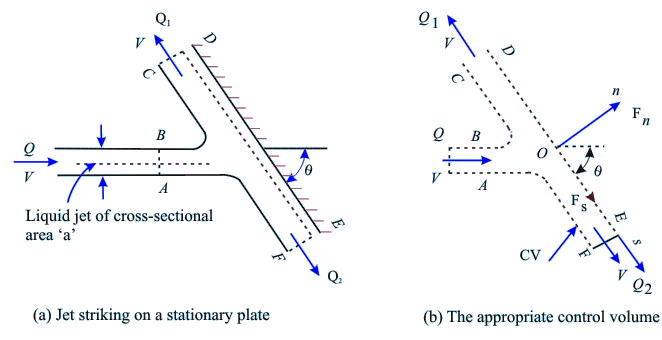|
Dynamic Forces on Plane Surfaces due
to the Impingement of Liquid Jets
Force
on a stationary surface Consider
a stationary flat plate and a liquid jet of cross sectional
area ”a” striking with a velocity V at an angle
θ to the plate as shown in Fig. 11.3a.

Fig 11.3 Impingement
of liquid Jets on a Stationary Flat Plate
To calculate the
force required to keep the plate stationary, a control volume
ABCDEFA (Fig. 11.3a) is chosen so that the control surface
DE coincides with the surface of the plate. The control volume
is shown separately as a free body in Fig. 11.3b. Let the
volume flow rate of the incoming jet be Q and be divided into
Q1 and Q2 gliding along the surface
(Fig. 11.3a) with the same velocity V since the pressure throughout
is same as the atmospheric pressure, the plate is considered
to be frictionless and the influence of a gravity is
neglected (i.e. the elevation between sections CD and EF is
negligible).
Coordinate axes are chosen
as 0s and 0n along and perpendicular to
the plate respectively. Neglecting the viscous forces. (the
force along the plate to be zero),the momentum conservation
of the control volume ABCDEFA in terms of s and n
components can be written from Eq.(10.18d) as
 |
(11.5a) |
and
 |
(11.5b) |
where Fs
and Fn are the forces acting on the control volume
along 0s and 0n respectively,
From continuity,
With the help of Eqs (11.5a)
and (11.6), we can write
 |
(11.7a) |
 |
(11.7b) |
The net force acting on the
control volume due to the change in momentum of the jet by
the plate is Fn along the direction "On” and is given by the Eq. (11.7b) as
 |
(11.7c) |
Hence, according to Newton’s
third law, the force acting on the plate is
 |
(11.8) |
If the cross-sectional
area of the jet is ”a”, then the volume flow rate
Q striking the plate can be written as Q = aV. Equation (11.8)
then becomes
 |
(11.9) |
|